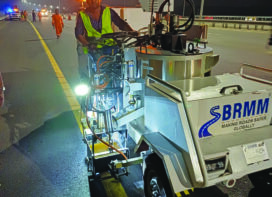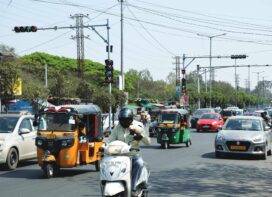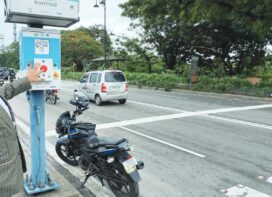Beginning of Reality – The Resucitation Process
 The TCRIP, which was doomed in 2006 to a premature closure with an unquantifiable extent of misery in store for the citizens of Thiruvananthapuram, sprung back into life by May 2009. In retrospect, the insight into the events that led to the revival needs a special mention as this could be the concoction that could be an assured remedy for the malady that usually plagues development projects in Kerala.
The TCRIP, which was doomed in 2006 to a premature closure with an unquantifiable extent of misery in store for the citizens of Thiruvananthapuram, sprung back into life by May 2009. In retrospect, the insight into the events that led to the revival needs a special mention as this could be the concoction that could be an assured remedy for the malady that usually plagues development projects in Kerala.
The failure in 2006 by the Government was partly as a result of political manipulation and undermining by vested interests to assert their role and superiority and protect their properties. In addition, many an engineer in the PWD did not approve of the project, as it attempted to set precedence in technology, methodology as well as assurance of quality. This was bound to change the equations in totality and hence there was opposition from within the Department too. There was not a ray of hope of revival of the project and the LA activity; at least until one day the Minister for Works’ passing comment that revival can take place only if there is a public acceptance of the project.
What transpired thereafter was a slow and painstaking process of interactions initiated by TRDCL with Residents Associations, Professional Associations, schools, colleges and various other gatherings where the organisers were willing to spare a few minutes for listening to the finer details of the project. Slowly a large cross section of the local public became aware of what they were going to miss if the Project was not revived. In many of these interactions, members of the press had participated outside their official capacity. But having heard TRDCL out, they were convinced about the value of the story. This saw the Press taking up the TCRIP news on a regular basis, more often than not bringing out the features of the project that touch the ordinary people positively.
Here was a clear example of how the media, labelled as the mother of all problems in a literate state like Kerala, could be the catalyst for positive result. The only difference was that TRDCL took pains to educate the correspondents on technical issues, sometimes going to the extent of even making working models.
Once the public and media were in tandem, gunning for revival of the Project, the politico did not think twice. And, that was how the revival process started, with the Government agreeing for an Arbitrated Settlement and reviving the balance process.
TCRIP – A New Experiment, a New Success of Sorts, a forerunner for Urban Scenario
 By now, there was a mass realisation (really, as people from across the world have taken note of this small City’s achievement) that TCRIP has become a reality. Where nothing out-of-the-box can survive more than a few days, here was a project estimated at a landed cost of `225 crores becoming a reality. While the trauma and the real efforts that went on to overcome the hurdles and eventually deliver the project would always remain a potential case study for the management students, the people of Trivandrum started seeing that things can work. Their confidence level in the government, its representatives and above all, in IL&FS – the diligence and commitment of IL&FS in delivering the project through TRDCL – went up. It is interesting to note how the public ethos has entwined with that of the project.
By now, there was a mass realisation (really, as people from across the world have taken note of this small City’s achievement) that TCRIP has become a reality. Where nothing out-of-the-box can survive more than a few days, here was a project estimated at a landed cost of `225 crores becoming a reality. While the trauma and the real efforts that went on to overcome the hurdles and eventually deliver the project would always remain a potential case study for the management students, the people of Trivandrum started seeing that things can work. Their confidence level in the government, its representatives and above all, in IL&FS – the diligence and commitment of IL&FS in delivering the project through TRDCL – went up. It is interesting to note how the public ethos has entwined with that of the project.
In the process of its interactions with the public, TRDCL discovered that many of the project features were unique in the context of the place and ethos of the public. Some of them were eye-openers. These would go down as just another project feature in any other city, but here it had either a special social impact or an impact affecting the way people reacted. Some were normal specifications, but were being insisted on for the first time in Kerala. For example, the construction requirements in the Concession Agreement specified utilisation of 60-70 bitumen as well as use of batch Type Hot Mix Plant for the asphalt work. This ensures the best riding quality. Though this would have gone unnoticed, the ride quality of TCRIP roads is now the benchmark for the local public. One reason could be the TRDCL brought out the reason for the superior ride quality in the press, correcting a notion of “rubberised road” for any road laid with a paver. Such simple technical information empowered the public to demand the same methodology in construction.
Some of the important features that can be brought under this category are;
Mountable Footpath: A brilliant adaptation of Dr. Sreenivasan. He argued that we should not go by standard 20cm or 25cm high footpath segregating the carriageway, but a footpath which is less than 10cm in height. Reason he put forward was that when the capacity of the road is exceeded in time, till alternatives are found, mountable footpath would help ease very high congestion. Also, in the absence of any significant plan for parking facilities, the roads would become logical parking areas. High footpath would make four-wheelers park away from the footpath to enable opening of the doors of the vehicle, thereby eating up precious carriageway.
TRDCL modified this also to avoid provision of cuttings in footpath to provide for property entrances. The footpaths being mountable, vehicles could slow down take a slow turn into the property mounting the footpath. Advantages were:
a. The pedestrian gets protected from rash entry by the vehicle driver.
b. People using the footpath, especially old people and children, do not have to climb down and climb up every time there is a cutting for a property entrance.
c. Morning walkers, who are in plenty in every corridor in a city like Trivandrum, can walk without getting worried about concentrating on the ground.
Challenges: TRDCL faced many challenges in implementing this. Property owners objected to this saying that they need cutting in the footpath. Our positioning as a pedestrians advocate countered all objections, even if the opinion of self appointed “experts” in the Road sector differed. Pressure from high offices for individual exemptions also was countered stating the need to have a uniform policy and not one that can be altered at will.
Footpath with Interlocking Blocks: Not a unique idea in any sense. But given the fact that the DPR insisted on 25mm cobbler (hand crafted) stones on 20mm mortar, this was a great initiative. TRDCL argued that fixing of cobbler stones are not advisable in view of the following:
a. Being city roads, the ribbon beyond the ROW is under constant development. This means that there is a continuous demand for laying or augmentation of utility lines. Every time the surface is dug up for such an activity, restoration to original condition is difficult if the footpath is paved using tiles on mortar. Such restoration also becomes highly expensive.
b. In a region that has close to 1.3m of rains annually, with dry period only from mid January to mid April, the surface of such stone tiles will become slippery and hazardous to pedestrians. The very advantages that we are providing to the pedestrians will get negated on account of this.
c. Rain water will be carried away into lakes and sea far off by directing into the drains. This is an environmental loss.
 TrafficInfraTech Magazine Linking People Places & Progress
TrafficInfraTech Magazine Linking People Places & Progress



